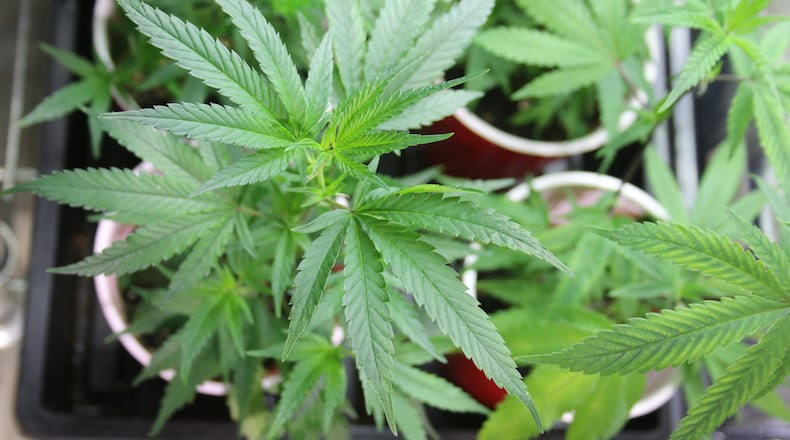“As might be expected, after five years it’s time to make some improvements to the program,” Huffman said.
Credit: Andrew Welsh-Huggins
Credit: Andrew Welsh-Huggins
The changes he proposes are the result of extensive discussion with medical marijuana businesses and patients, he said.
To the 21 conditions already eligible for medical marijuana, SB 261 would add:
• Arthritis
• Migraines
• Autism spectrum disorder
• Spasticity or chronic muscle spasms
• Hospice care or terminal illness
• Opioid use disorder, and
• Any other condition a recommending physician believes medical marijuana would help.
“That’s kind of a catchall phrase that will use the doctor’s education to decide,” said Huffman, who’s also a physician.
State Sen. Sandra Williams, D-Cleveland, asked how Huffman compiled the enlarged list of eligible conditions, and how doctors’ discretion in prescribing for unspecified conditions would be regulated.
Huffman said the named conditions came from advocacy groups, and that prescriptions for medical marijuana would be monitored the same way all other prescriptions are.
“It’s up to the education of the physician to say this is a valid reason or this is not,” he said.
Among the bill’s supporters is Andrew Rayburn, owner of Buckeye Relief in Eastlake, Ohio’s first level one cultivator and processor. He also heads the Ohio Medical Cannabis Industry Association, and plans to expand his business.
“We will be opening our first dispensary around Feb. 1,” Rayburn said.
The number of Ohio patients eligible for medical marijuana is growing by 5,000 to 10,000 per month, but only 57 dispensaries exist statewide, he said. There is an “application window” for 73 more, Rayburn said, and that should help bring prices down.
“The ultimate pricing of our product occurs at the dispensary level,” he said.
Medical marijuana costs Ohio patients about $310 an ounce, “which is much higher than any other surrounding state,” Huffman said. A big reason many of those eligible never buy medical marijuana is that they just can’t afford it, he said.
As of September, according to the Ohio Board of Pharmacy, nearly 360,000 people in Ohio had been recommended for medical marijuana use, but only about 130,000 had active registration and recommendations. Altogether, fewer than 200,000 people had bought from licensed dispensaries.
Ohio issues two levels of cultivator licenses for marijuana. A level one license allows a growing operation of up to 25,000 square feet, while level two authorizes up to 3,000 square feet. Growers complained those levels were set when few people had qualified to receive the drugs.
Huffman’s Senate Bill 261 would write into law a September announcement from the Ohio Department of Commerce that licensed growers could apply to expand their operations. Under the new rules level one license-holders could grow on up to 75,000 square feet, and level two growers could use up to 20,000 square feet.
The proposal would also increase the allowable number of dispensaries in the state, based on the number of patients. In some areas, such as northwest Ohio, people may have to drive an hour to find a dispensary, Huffman said. His bill would allow one dispensary to open for each 1,000 eligible patients in the state.
Today there are more than 6,000 patients for each dispensary in the state, Huffman said.
Tim Johnson, head of Ohio Cannabis and Hemp Chamber of Commerce and Cannabis Safety First, introduced himself as a U.S. Air Force veteran, retired law enforcement officer, medical marijuana patient and one of the drivers behind HB 523.
He supports SB 261, but urged legislators to add legal protections for patients’ jobs, parental rights and gun ownership.
The bill would also expand the ways medical marijuana can be administered. It currently can already be taken as an oil, tincture, plant material, edible or a patch. Huffman’s bill would add:
• Pills, capsules and suppositories.
• Oral pouches, strips or sprays.
• Topical sprays, salves or lotions.
• Inhalers.
• Any other form the state Board of Pharmacy approves.
Huffman said there is still no consideration of allowing medical marijuana users to smoke it.
The bill would let licensed dispensaries advertise, on social media or elsewhere, without prior approval from the Division of Marijuana Control. Licensed dispensaries could also put their products on display in-store and in ads.
Currently, all advertising must be submitted to the state for prior approval, Huffman said.
The new rules would retain an adjustment made for COVID-19, allowing drive-up and curbside dispensing, Huffman said. Many disabled patients, especially veterans, have trouble getting out of vehicles and going inside a building, he said.
Huffman introduced the bill Nov. 9, and it has been referred to the Senate Small Business & Economic Opportunity Committee. It’s cosponsored by Senate Minority Leader Kenny Yuko, D-Richmond Heights.
About the Author


